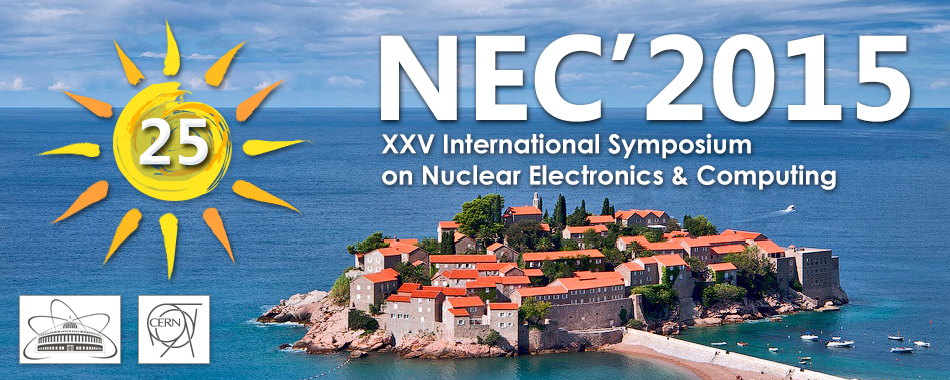Conveners
Distributed Computing. GRID & Cloud computing
- Mohammad Al-Turany (GSI/CERN)
Distributed Computing. GRID & Cloud computing
- Patrick Fuhrmann (DESY)
Distributed Computing. GRID & Cloud computing
- Milos Lokajicek (Institute of Physics AS CR)
Distributed Computing. GRID & Cloud computing: Distributed Computing. GRID & Cloud computing
- Viacheslav Ilyin (NRC Kurchatov Institute)
Mr
SEBASTIAN BUKOWIEC
(CERN)
01/10/2015, 09:00
The continuous growth of luminosity in high energy physics with the LHC restart in 2015 results in larger amount of data to be analysed and a corresponding increase in computing power.
Given these challenges, we have adopted a number of open source projects used by other large scale deployments elsewhere and contributed to those communities.
In particular, OpenStack was chosen as the...
Prof.
Alexander Bogdanov
(St.Petersburg State University)
01/10/2015, 09:30
To have computing power of large system in hand was a dream of computational scientists for a long time. There were a lot of very interesting proposals in that direction, but there always were bottlenecks, that managed to ruin the original idea. We review some of those problems and argue that new technologies can bring solutions at least to majority of them. The use of cloud technologies...
Prof.
Gennady Ososkov
(JINR)
01/10/2015, 10:30
The simulation concept for grid-cloud services of contemporary HENP experiments of the Big Data scale was formulated in practicing the simulation system developed in LIT JINR Dubna. This system is intended to improve the efficiency of the design and development of a wide class of grid-cloud structures by using work quality indicators of some real system to design and predict its evolution. For...
Dr
Alexei Klimentov
(Brookhaven National Lab), Mr
Dimitrii Krasnopevtsev
(National Research Nuclear University MEPhI (RU))
01/10/2015, 11:10
After the early success in discovering a new particle consistent with the long awaited Higgs boson, Large Hadron Collider experiments are ready for the precision measurements and further discoveries that will be made possible by much higher LHC collision rates from spring 2015. A proper understanding of the detectors performance at highoccupancy conditions is important for many on-going...
Andreas-Joachim Peters
(CERN)
01/10/2015, 11:30
The EOS project at CERN is providing large scale storage systems to LHC experiments and many other projects at CERN and beyond. In order to further increase the scalability and availability of the system we are investigating several new technologies such as ethernet connected disk drives and non-volatile memory implementations to further decrease the cost of ownership and the downtime after...
Dr
Andrei Tsaregorodtsev
(CPPM-IN2P3-CNRS)
01/10/2015, 12:00
Multiple research user communities need to put in common infrastructures their computing resources in order to boost the efficiency of their usage. Various grid infrastructures are trying to help the new users to start doing computations by providing services facilitating access to distributed computing resources. The DIRAC project is providing software for creating and operating such...
Mr
Jan Kundrát
(Institute of Physics of the AS CR and CESNET)
01/10/2015, 14:00
Mr
Nichita Degteariov
(RENAM)
01/10/2015, 14:15
In recent years distributed information processing and high-performance computing (HPC, distributed Cloud and Grid computing infrastructures) technologies for solving complex tasks with high demands of computing resources are actively developing. In Moldova the works on creation of high-performance and distributed computing infrastructures were started relatively recently due to participation...
Mr
Vitaly Yermolchyk
(NC PHEP BSU)
01/10/2015, 14:30
Status of the NC PHEP BSU Tier 3 site presented. Transition to rackmounted servers started. Due to need in more scalable, reliable platform which provide efficient resource utilization tier infrastructure was ported on cloud with distributed storage. The choise and setup of cloud is discussed.
Furano Fabrizio
(CERN IT/SDC)
01/10/2015, 15:05
The Dynamic Federations project ("dynafed") enables the deployment of
scalable, distributed storage systems composed of independent storage
endpoints. While the Uniform Generic Redirector at the heart of the
project is protocol agnostic, we have focussed our effort on HTTP-based
protocols, including S3 and WebDAV. The system has been deployed on
testbeds covering the majority of ...
Dr
Nikolay Kutovskiy
(JINR)
01/10/2015, 15:20
To fulfill JINR commitments in different national and international projects related to modern information technologies usage such as cloud and grid computing as well as to provide the same tools for JINR users for their scientific research the cloud infrastructure was deployed at Laboratory of Information Technologies of Joint Institute for Nuclear Research. OpenNebula software was chosen...
Mr
Igor Pelevanyuk
(JINR)
01/10/2015, 16:05
The BES-III experiment at the Institute of High Energy Physics (Beijing, China) is aimed at the precision measurements in e+e- anihilation in the energy range from 2.0 till 4.6 GeV. The world largest samples of J/psi and psi' events and unique samples of XYZ data have been already collected. Expected increase of the data volume in the coming years required significant evolution of the...
Dr
Sergey Manoshin
(FLNP JINR)
01/10/2015, 16:35
At present days practically each new neutron spectrometer before construction or modernization is simulated, and its parameters are optimized with use of calculations on fast modern computers. In several leading world neutron centers development new and support of old program packages (MCSTAS, VITESS, RESTRAX, NISP) with use of a method of Monte Carlo is conducted. In FLNP modules for...
Dr
Charalampos Kouzinopoulos
(CERN)
01/10/2015, 16:50
The Hough Transform algorithm is a popular image analysis method that is widely used to perform global pattern recognition in images through the identification of local patterns in a suitably chosen parameter space. The algorithm can be also used to perform track reconstruction; to estimate the trajectory of individual particles when passed through the sensitive elements of a detector volume....
Dr
Alexander Kryukov
(SINP MSU)
01/10/2015, 17:05

